Search Results
More than an art fair, NEXT is a showcase for the world’s talents and an adventure in innovative culture. An opportunity to redefine the relationship between art and its public, NEXT is a platform for established and emerging galleries to promote the work of cutting-edge artists. NEXT is dedicated to the exhibition and advancement of today’s art. NEXT is the catalyst for the exchange of information and experimental ideas aimed at today’s educated collectors.
For the second year in a row we have made it happen we will be showing our art at one of the world’s largest art events. Last year we made our debut as Allen Vandevers Project space and had great success. The art world used to seem like this mystical place that was only found in fairy tales. Last year we discovered this land and it was as strange and bizarre but magical and beautiful. I hope you come visit us while we secure our foot hold and place in the art world.
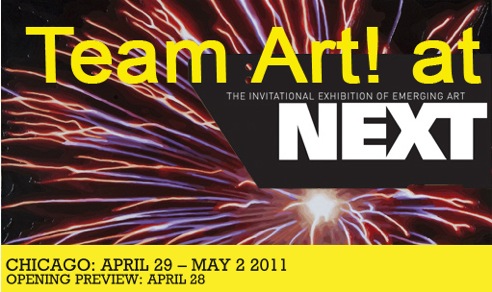
Posted: April 5th, 2011
at 12:25pm by Koookiecrumbles
Tagged with art, allen vandever, NEXT, Art Chicago, chicago, art painting, Team Art, next art fair
Categories: art,contemporary,events
Comments: No comments
Team Art! hits the big time at Art Basel Miami.
Allen Vandever says it was every thing he dreamed of and more, an artist wonderland.
To find out more about Team Art! click here.
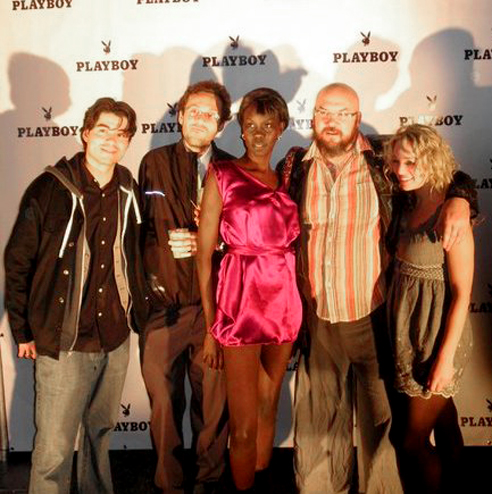
Pictured: Armando Perez, Mike Reynolds, Nunu Deng, Allen Vandever and Rachel Slotnick
Posted: December 13th, 2010
at 3:23pm by Koookiecrumbles
Tagged with allen vandever, Alan Vandever, Playboy, Team Art, basel, miami
Categories: celebrity,art,contemporary,et cetera,events
Comments: No comments
Armando Perez and Allen Vandever who were featured in the first episode ofAthe DOJO have teamed up with Mike Reynolds and Rachel Slotnick for this year’sAMiami’s Verge Art Fair, a part of Art Basel to formATeam Art! You can see more of Vandever’s art and listen to some of Perez’s music (the Single Helix) at myninjaplease.
You can follow and contact the teamAhere!
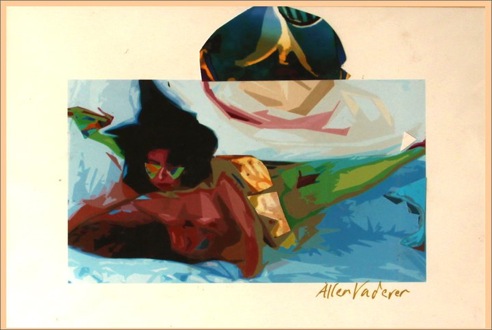
Posted: December 5th, 2010
at 8:43pm by Koookiecrumbles
Categories: music,contemporary,events
Comments: 1 comment
First of all, I’m going to have to thank NPR for helping us out on our ART Friday grind this week.AA Also, to those of you who aren’t hip to what ART Friday is, we try to post some new artwork every week.AA ART Friday is not limited to the visual arts, although they do lend themselves nicely to blog posting.
Sometimes on Fridays you’ll get analysis (UM… in a limited sense).AA Other times we’ll just make fun of whatever it is we’re posting.AA Still, other times you might just see pictures and links.
Krumbles and Ock, two of our resident bloggers, have been tag-teaming ART Fridays for quite a long time, but had recently fallen off, which accounts for the holes in the calendar.AA At the same time as Ock resurrected the idea, Krumbles jumped off the newest (and probably most interesting) part of the feature: A Dozen.AA In this feature, Krumbles interviews different artists (local and famous) and asks them about their specific media.
Keep an eye out for all that goodness and more in the coming weeks as we re-launch our Art Store and prepare for the new blogging season (yes we treat this ish like professionals - trading people to other blogs and whatnot).AA But anyway, on to this week’s spectacular…
So I was listening to/reading NPR when I found this little piece about an unused plinth in Trafalgar square which has now been converted into a public art project.AA I’ll let you read the article yourself:
All Things Considered, July 6, 2009 AA In the northwest corner of Trafalgar Square, in the heart of
London, there is an empty base, or plinth, for a statue. Unlike the others there, the Fourth Plinth, as it is sometimes called, never had the bronze likeness of a British hero placed upon it.
Now the vacant plinth, built in 1841 for an equestrian statue that was never created, is being put to use for a new art project that began Monday. Officially called "One & Other," the project will involve 2,400 members of the general public a€" chosen randomly from 18,000 applicants a€" acting, singing, jumping, shouting or doing whatever they want upon the plinth for one hour each, around the clock for 100 days.
It’s being called the ultimate democratization of art a€" whereby Joe or Josephine Schmo gets to stand on a plinth in the heart of the nation’s capital for a whole hour under the gaze of Lord Horatio Nelson, the hero of Trafalgar, and other heroes of the Empire.
While I clearly wouldn’t use such terms as the "ultimate democratization of art" (art is pretty frickin’ democratic…) I will say that this is an awesome idea.AA I particularly like the non-clarity of the metaphorical implications of a rando becoming the central figure on an haphazardly unused 1847 dais.AA It’s doing something subtle, drawing the comparison between the regular person’s expression and the commissioned artist, drawing a clear link to the past -which art (and architecture) is constantly doing wordlessly while reminding us that the present is constantly becoming the past.AA There is little visual representational art that can even be claimed to have a quality of ‘existing outside of time’ - which is the genius of this project.
I also find it interesting that all of a sudden the "statue" is regarding the onlooker with real blinking eyes.AA I always imagine those old statues peering back at me, stuck in one position eternally.
:: [ Go Read the Rest at NPR ] ::
Posted: July 17th, 2009
at 7:43am by Black Ock
Tagged with collab, collaborative art, public art, UK
Categories: art fridays
Comments: No comments
We’re all aware of famous renditions of natural disasters and human catastrophes in the works of several famed and celebrated artists. In fact, it would seem that periods of civil unrest have always had a tendency to lead to great works of art. One theory is that because art tends to reflect, amplify, or (in some cases) dictate what goes on in society it is only natural that these occurrences would appear in the artwork of the period. Here are some possibly overly famous examples (hyperbolized as they may be) of artists who have one way or another painted catastrophes.
Goya, who you probably should know, looked upon the horrors of the Bourbon reign Spain and painted his classic painting el 3 de Mayo. The painting is as politically motivated as anything else this master painted, but it goes a long way into describing the human cost of catastrophe, albeit political and not natural.
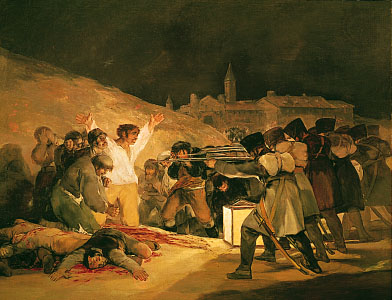
Any Art History student will quickly point out the obvious connection of the central figure to Christ crucified. There’s also the innocent white shirt he’s wearing and they way he stands in front of the other villagers in defiance, as if to beg the question "why are the innocents being murdered?" The French army stands in formation like a machine, bunched together as if they are on force, one nation, one idea. There is no individual here, but an act of violence by one people on another, innocent and unarmed people (represented by one crucial figure).
Picasso is another artist who points out the absolute catastrophe of war. His painting, Guernica, like Goya’s points out what seems to be the senselessness of human massacre. He includes all types of human made objects,a broken statue, an exploding lightbulb (a play on words, for "bombilla" in Spanish means lightbulb) and contrasts them with the pain that the natural objects (ie. people/horse) seem to be feeling.
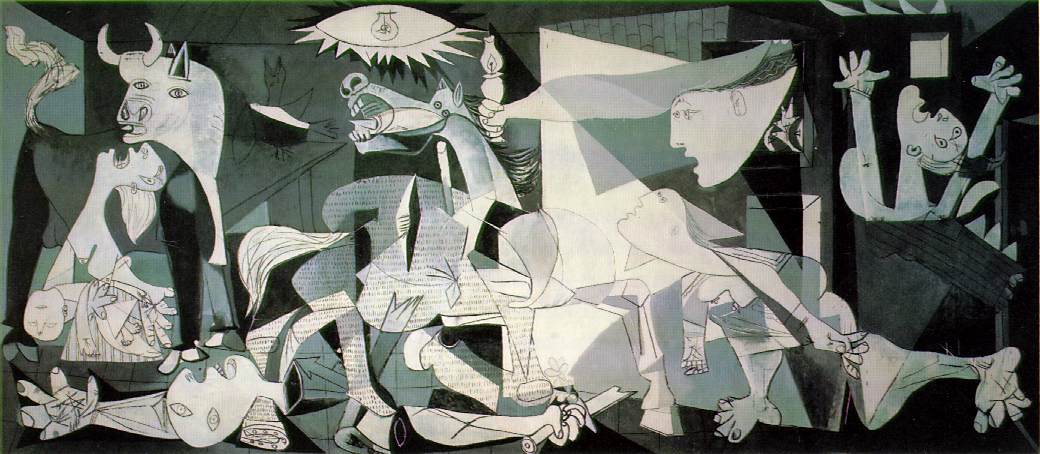
In this painting things are out of order, the world has gone mad and catastrophe abounds.
This majestic work, The Polar Sea [Caspar David Friedrich] (dating from 1823-4) features in an exhibition that has just moved from Berlin to Hamburg, where it hangs opposite one of Friedrich’s grandest canvases, the depiction of the vast snow-capped mountain, The Watzmann. The iceberg painting shows nature rejecting man’s intrusion - the ship having been destroyed by the immense force that has pushed the blocks of ice upwards into a striking pyramidal composition. The mountain, another pyramid, seems to lie beyond human intervention. The large canvas is quite without signs of human or other animal life. [link]
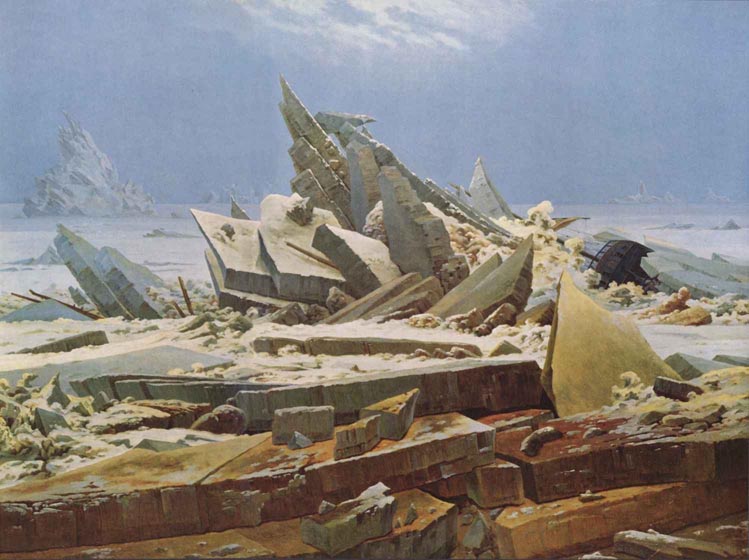
This ART DAY! is obviously partially focused on disasters. I was inspired by the foto av dagen that was posted on green.mnp and that is featured below. The point of this ART DAY! is not to depress you, but rather to force you to think critically thabout how artists depict things that are going on around them that they love, hate, and are awed by.AA Keep these paintings in mind as you maneuver through today’s features.
No, we’re not talking about graffiti, even though we got love for the writers out there. To take a break from our 4-part Asian Art series, and to let us Rockies and Sox fans both recover from devastating mid-week hangovers, we present to you the Coors Lite version of ART DAY!.
Today we’ve thought up a new trick for you; we’ve decided to take this Art Game local and straight to your door. A lot of how we feel about art, as we discussed briefly last week, is that you have to see it to be affected by it. There’s really no reason you should see thousands of billboards and commercials every day and at least not also get a dose of what we civilized people call fine art.AA And art itself is all about how much the viewer values whatever he or she is looking out.AA In order to participate in the Art Game, all you gotta do is look and be a critic, like and dislike.
That’s why every Friday, pretty much rain, hail or snow (and barring such events such as earthquake) we bring you ART DAY! Most ART DAY! posts today feature artists and/or exhibits that you can see around the local Boston or Chi Town area. They don’t need much introduction so we’re just going to jump right in. The important thing to remember about ART DAY! is to click the pics, they will take you to the worthy sources.
I’m happy to report that I’ll be one of twenty artists participating in "The Wall at Central Square" in Cambridge, Massachusetts this week.
Located in the heart of Central Square at 567 Mass Ave., this 81 - foot long wall will present work by internationally known street artists from around the country. This is the first time an event of this magnitude has been done in the Boston Area, which will include poster, painting, 3 - D, graffiti, stencils, and stickers. The exhibit will be open to the public.
My contributions include a giant, pink flower painting and four pasted paintings on paper.
Be sure to check out the press release for all the details.
Many many thanks to Geoff and Gary!
The Wall at Central Square
Artists Panel and Discussion
(participants TBA)
Saturday, October 27, 6pm-7pm
Enormous Room
567 Massachusetts Avenue
Cambridge
A private party will follow.
In case you missed my talk a couple of weeks ago at OPEN SPACE Gallery in Beacon, be sure to check out the audio of it here:
Dan Weise of the gallery and I chat about my exhibition at their space, my work and more. It was a real honor to be featured as their guest as well as be their inaugural show.
The exhibition is up until November 4th so there’s still time to come by and check it out!
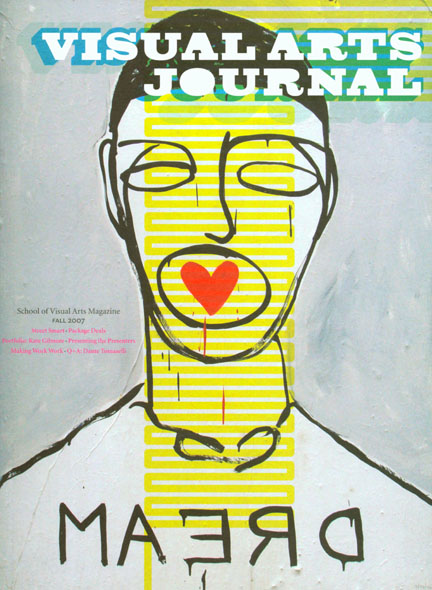
For those of you School of Visual Arts alumni out there, be sure to check out the Fall issue of Visual Arts Journal. Kathleen Boyle wrote a nice piece about five SVA alumni that use the streets as a canvas for their work: Keith Haring, Rodney Alan Greenblat, Kenny Scharf, KAWS and myself.
The cover (shown above) features my self portrait on West 22nd Street in Manhattan. I pasted that piece up in July of 2006 and the last time I checked it’s still there holding on strong!
What, you thought we were done? Nah fool, it’s only 10 AM. Stay tuned for more throughout the day and scroll on down to check out the rest of this morning’s content.
Posted: October 26th, 2007
at 10:11am by Black Ock
Categories: hood status,art,contemporary,art fridays
Comments: No comments
Welcome back to ART DAY! my peoples. Once again my man Koookiecrumbles and I tag team you with the latest art that you should be checking out. The theme is still Asian art, and no, it hasn’t gotten less general.
Last week we talked about woodblocks and we somewhat touched on the fact that many impressionists (as well as artists of other movements) were deeply inspired by Japanese woodblocks of the 18th-19th century. Today we explore the parallels a little bit deeper.
To start, we look at at a Van Gogh painting, which is taken from Hiroshige.
Vincent Van Gogh, during the first experiments marking his turn to impressionism, once meticulously copied a blooming plum tree from a Japanese woodblock print to explore the effects of juxtaposition of contrasting colors, which are typical of ukiyoe prints. [via]
Now if you don’t know Uttagawa Hiroshige, then you either never studied art history or you don’t spend enough time on Wikipedia, but don’t worry, we’ll fix that.
He dominated landscape printmaking with his unique brand of intimate, almost small-scale works (at least when compared against the older traditions of landscape painting descended from Chinese landscape painters through Sesshu). The travel prints generally depict travelers along the famous routes traveling and experiencing the special attractions of various stops along the way. They travel in the rain, the snow, and during all of the seasons. In 1856, working with the publisher Uoya Eikichi, he created a series of high quality prints, made with the finest printing techniques including true gradation of color, the addition of mica to lend a unique iridescent effect, embossing, fabric printing, blind printing, and the use of glue printing (wherein ink is mixed with glue for a glittery effect). One Hundred Famous Views of Edo (issued serially between 1856 and 1859) was immensely popular. The set was not published until after his death, so not all of the prints were completed by him-he created over 100 on his own, but two were added by Hiroshige II after his death.
Fixed? Okay, now look at some of this work. You’ll notice that the Ukiyo-e theme that we discussed last week is present in his work, as well as the color juxtapositions that are discussed in the above quote. Note: these woodblocks are all by Hiroshige II but similar themes are expressed.
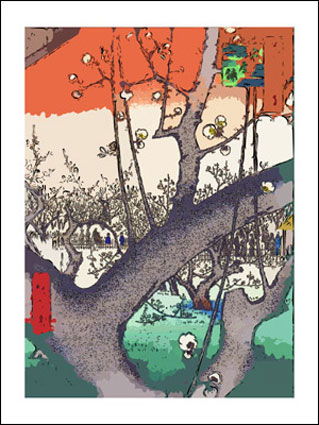
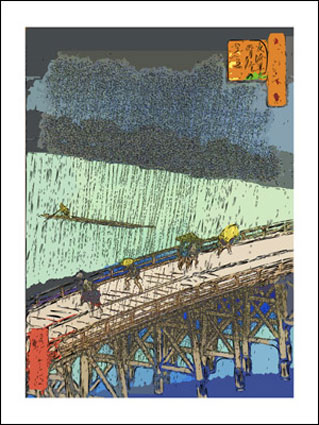
The effects of Europe’s impressionist movement were being felt in Asia. Japan was undergoing a period of radical modernization, which in the cultural field caused a great interest in Western oil painting. Two of the first Japanese teachers of Western oil painting, which became part of the official curriculum in the Tokyo School of Fine Arts in 1896, were Kuroda Seiki (AAA,A¥AA AAMAAAA) and Kume Seiichi ( A¤[ A¦A AAMA¤@), who both came back from Paris in 1893. They introduced impressionism and the free lifestyle of the French art scene to Japan. In 1907, the first show of original impressionist paintings was held in Japan, including works by Van Gogh, Paul Cezanne, and others. This was the year after Cezanne’s death, and a number of painters, including Renoir, were still quite active at the time. Ninety years later, it is almost the same group of artists whose works are on show at the National Museum of History in Taipei between January 15 and April 27, 1997. [Great Article on Impressionism and Taiwan]
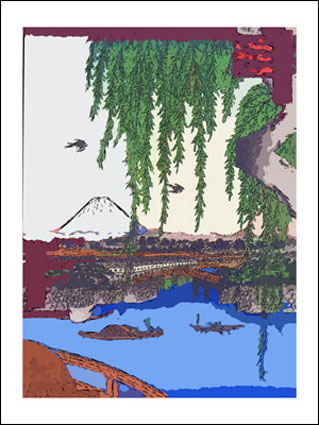
On a side note, I never thought about it before ,but, this artist is also referred to as Ando Hiroshige, which may or may not have a connection to Heroes characters Hiro & Ando. Um sorry, that was totally tangential.
Come to think of it, as long as we’re discussing whatever we want, one thing I may have neglected to mention was the importance of the landscape in Japanese woodblock. Japanese woodblock is a field with a lot of depth, and many of the scenes throughout the centuries feature interiors. But, one must not forget that the fine-ness of the protrayal of nature was also a critical element to Japanese woodblocks, and far-east art in general.
The impressionists, of course, were obsessed with light. Most of their compositions, in fact, it can be argued have something to do specifically with the portrayal of modern day scenes and the fleeting sense of light. It was almost as if the metaphor was that modern life was fleeting and ethereal in the same way that light conditions are (or were?). The eye perceives city-life and light in similar ways, in that there is an essential moment to be captured, which will be gone the next.
Compare the previous examples with these impressionist works:
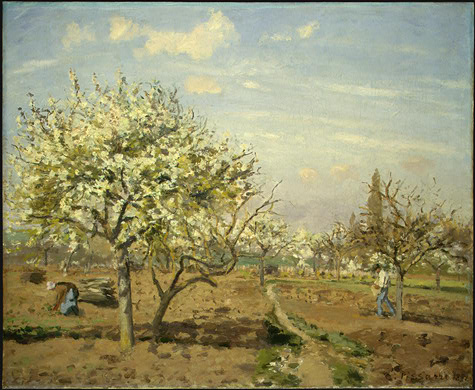
Orchard in Bloom, Camile Pissarro
He must have viewed the freshly plowed earth, like the spring blossoms that bring life to the dormant landscape, as a signal of renewed hope for his adopted country and for his career.
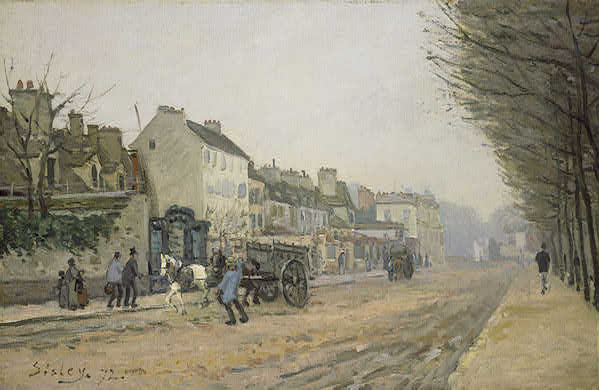
Boulevard HA©loAAse, Argenteuil, Alfred Sisley
He seems most concerned with its shapes and textures and the delicate colors of the pale winter sky. A softening of detail conveys the chill of a damp day. Of all the impressionists, Sisley was the one most committed to landscape and to the impressionist style in its most pure form, never abandoning, even temporarily, impressionism’s goal of capturing the transient effects of light and atmosphere.
These ART DAY! posts that delve into the historical realm are meant to be short introductions to topics that you really need to do more research about to form an opinion. After all, that’s what art is. As such, I invite any of my readers to contend with the notions I present, because it’s only discussion that engenders a true sense of understanding about these works. I personally believe that Japanese woodblocks are some of the best examples of what I will loosely term ‘populist art’ because of their general availability, cheapness (both reproduction wise and vendor wise), and expression of mass ideals. People actually went out and bought these paintings en masse which is different than the types of art most people are used to, the diversions of the rich and powerful.
Of course, no ART DAY! would be complete without a look at some of the more modern examples of the techniques about which we speak, so here goes:
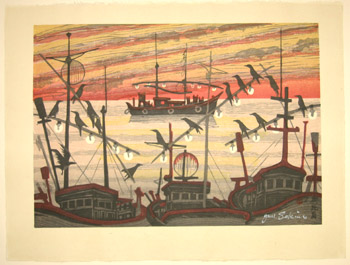
Okushiri Island, Jun Ichiro Sekino
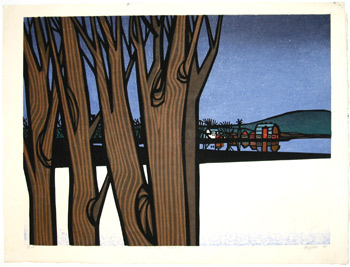
Winter Trees, Clifton Karhu
What? Stop looking so damned surprised! Just because there was no 2 hours on the internet this week doesn’t mean we would ever try to play you on ART DAY! For more of ART DAY! keep on scrolling down… and look forward to the return of 2 hours on the internet on Monday plus a new Saturday feature!
Posted: October 19th, 2007
at 9:25am by Black Ock
Categories: life,art,contemporary,boredom killer,art fridays
Comments: No comments
Welcome to ART DAY! We here at mnp think that you readers out there might be a little spoiled with expecting a themed ART DAY! and whatnot every damn week. SO just to keep you happy, I’ll announce the theme today as being that of Asian Art. It’s no more specific than that, but you know, keep it simple.
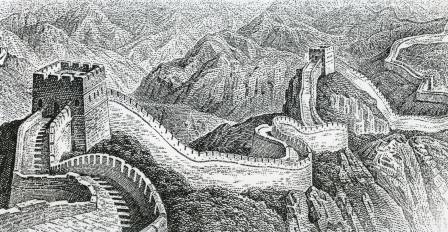
So way, way, way back in the day in China, like the year 500 or something, cats started doing a sort of art called woodcuts or woodblock prints. The method involves printing on to wood and the cutting away the unwanted parts. It’s pretty simple really, but some very stunning work comes out of that era. All of these initial images are examples of oldern Chinese woodcuts.
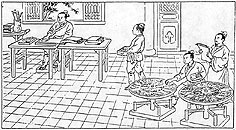
Mostly these woodblock or woodcut prints were used to accompany text in a sort of didactic way, not unlike early European illuminated manuscripts (except mad earlier). For instance, the earliest known Chinese woodcut (as in woodcuts with a date on them) accompanies the text of the Diamond Sutra, which is a Buddhist text.
The word [sutra] comes from Sanskrit, the ancient and sacred language of India. It means a religious teaching or sermon, and is most often used to describe the teachings of the Buddha. Sutras preached by the Buddha were committed to memory by his disciples and passed down from generation to generation. The illustration at the beginning of this a€Diamond Sutraa€™ shows the Buddha expounding the sutra to an elderly disciple called Subhuti. [via]
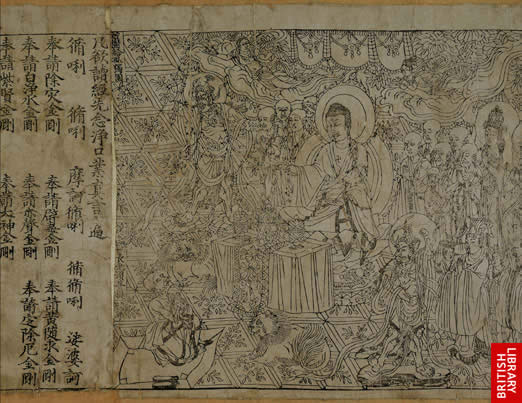
The Diamond Sutra - woodblock 9th century
Just like rice, pasta, and civilization, woodcut techniques eventually made it out of China and to everywhere else in the world, notably western Europe and Japan. In Europe, according to trusty Wikipedia, the technique developed around 1400 and was a descendant of techniques that were already in use for printing to cloth.
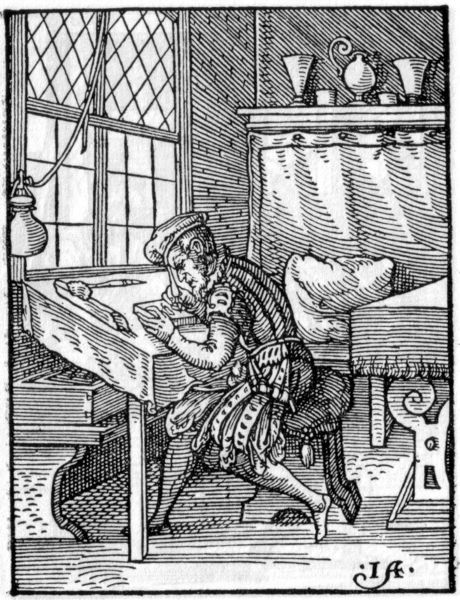
Jost Amman - Switzerland
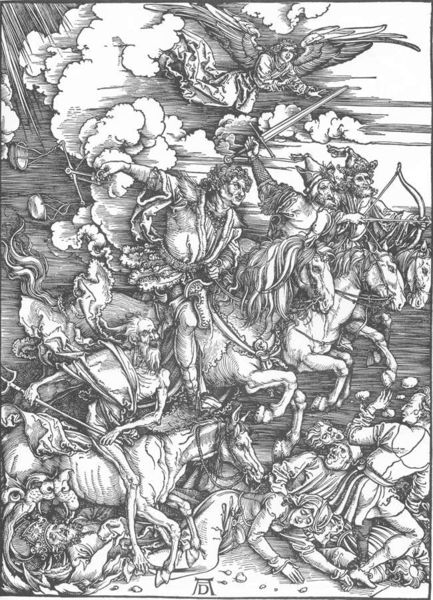
Durer - Germany
Despite (plenty) prolific European examples (Goya, Rembrandt etc.), the technique is widely associated with Japan, the source from which were inspired countless artists of the 19th century. Notably, the impressionists were very fond of woodblock (though not as a rule). That’s probably because woodblock in Japan shares a commonality with impressionism in that it sought to depict scenes from the the everyday life of the cityscape [Ed: See Ukiyo-e]. Almost as important was the fact that these joints were affordable because of the technique and the capabilities of mass-production.
So, like I said, Japan happens to be the focal point in woodblock printing.AA The Japanese were into all types of different woodblock paintings.AA A lot of them were actually of women participating in communal baths, which must have been a little bit risque at the time.AA It’s no wonder why they sold so well.AA Here are some examples:
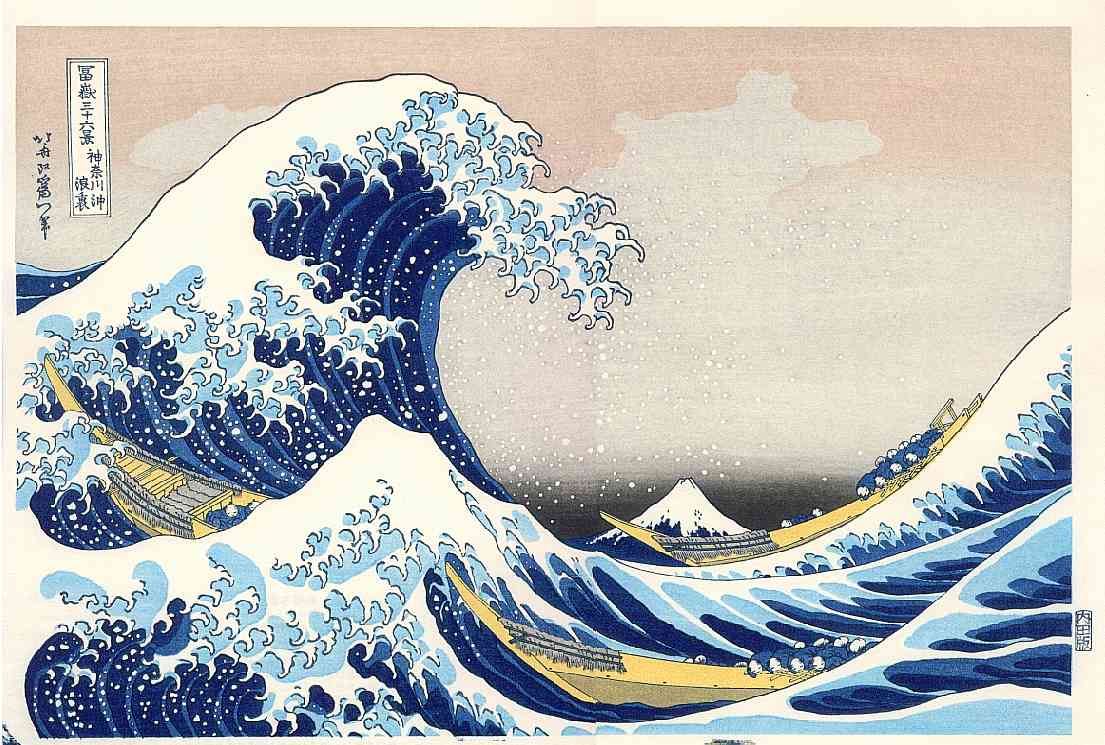
most everyone has seen this


This brings me to the section which is the crux of this post in general.AA I thought it would be fun to look at modern day examples of woodblock printing, Japanese and Chinese style.AA You can just call it ninja art if you want, although associating all ninjas with Japan or China would be a little bit racialist, if I do say so myself.
Here are some woodblocks by Norio Takamiya:
Takamiya includes contemporary ideas and characters into the whole woodcut business to basically create an ahistorical style that I find really ill.AA Below you find representations of a Japanese Cooper in Australia, Ned Kelly in Australia, amongst others:
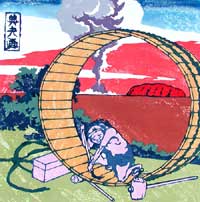
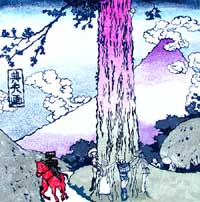
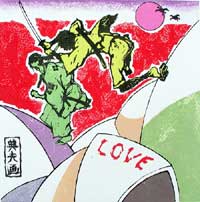
And next we have some examples of modern Chinese woodblocks:
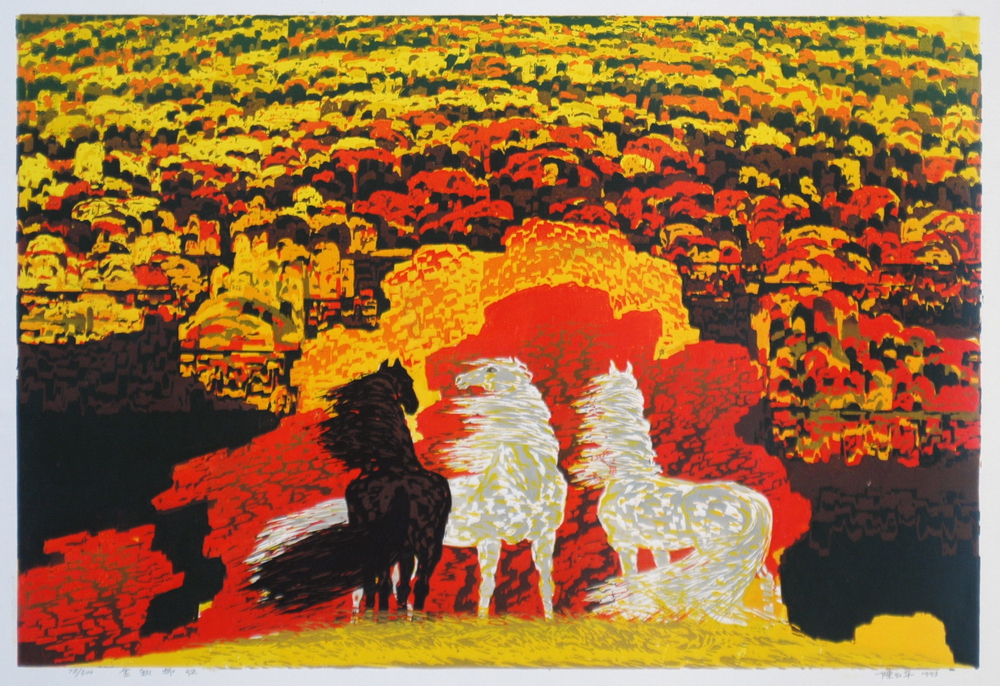
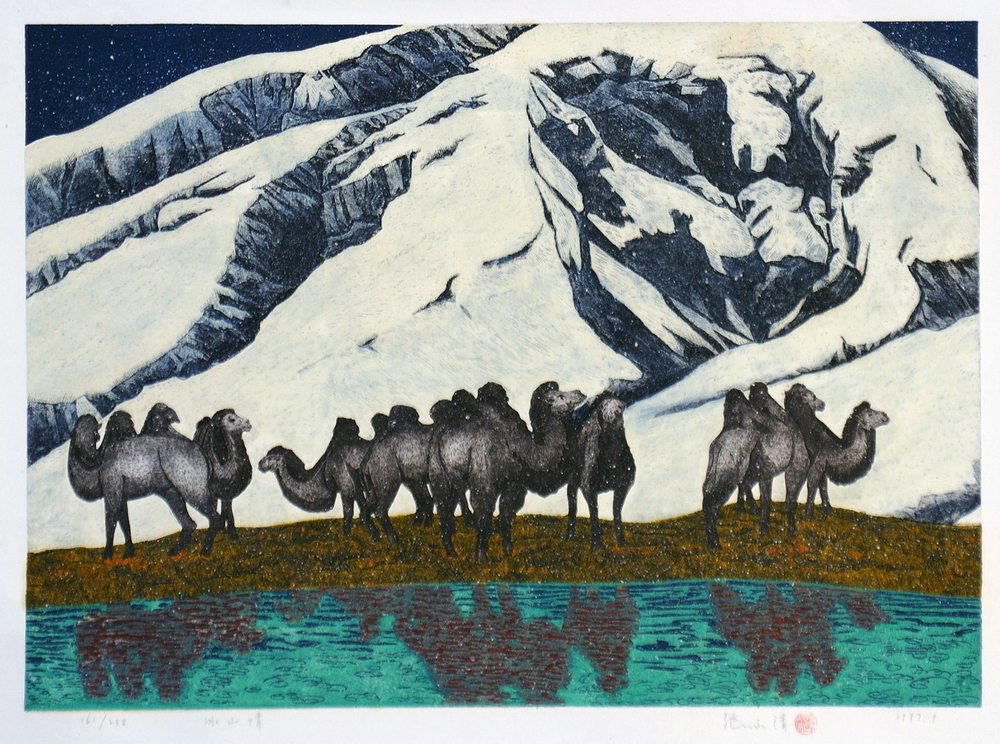
Keep scrolling down for more great ART DAY! content, and, stay tuned for part II of Asian Art!
Posted: October 12th, 2007
at 9:31am by Black Ock
Categories: art,contemporary,9th dan,art fridays
Comments: No comments